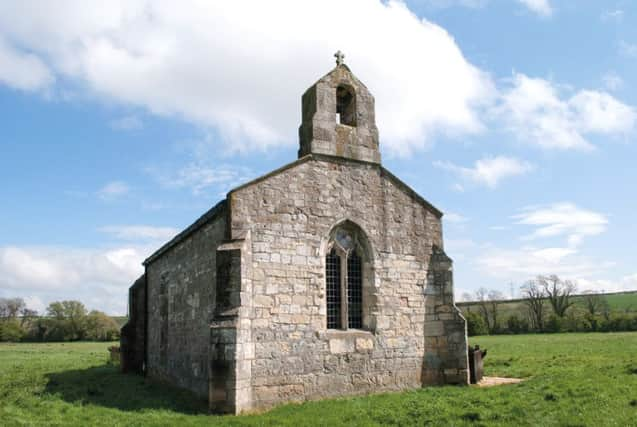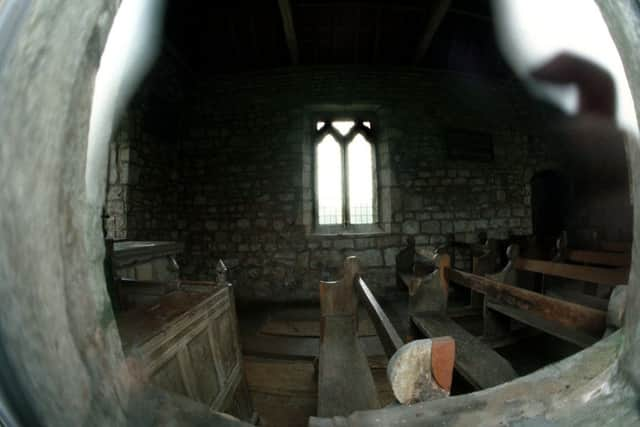Tiny time capsules


Over the past few years he’s sought out the best pocket-sized campsites, tracked down the country’s most minuscule railway stations and explored some of the world’s smallest islands. Now he’s turned his focus to churches. And, predictably, while most guides to Britain’s ecclesiastical past focus on grand architectural monuments like York Minster and Canterbury Cathedral, Dixe’s focus has been on the other end of the scale.
The resulting book, appropriately entitled Tiny Churches, features 60 of the best and most diminutive churches, from St Boniface Kirk on the northern Scottish island of Papa Westray to Our Lady and St Anne’s on the Bristol Channel.
Advertisement
Hide AdAdvertisement
Hide Ad“I do a lot of cycling and there is nothing I like more than exploring villages and having a nose around an old church,” says Dixe, who hails from East London. “Given that they have weathered several plagues, the Reformation, plummeting attendances and the Victorians, who were responsible for some awful additions to many of our best buildings, it’s amazing that so many have survived into the 21st century and this was my way of letting other people know what treasures they have on their doorstep.”


While Dixe had a few ideas of the churches he wanted to document, before he began his holy odyssey, he took himself off to the British Library and trawled their collection of rare books for inspiration. In the end he had a list of 100 possible churches and set off to see for himself which ones would make it into the final book.
“When I was writing Tiny Islands I was very clear that anything over 300 acres wouldn’t make the cut. This was a little less scientific and I didn’t feel the need to take a tape measure with me to determine the length of the nave or the aisle. This time ‘tiny’ was in the eye of the beholder, but you’d struggle to get more than 50 people in any of them.”
While all are still open to the public, most have never seen such a crowd for decades. However, if walls could talk, chapels like St Mary’s at Lead near Tadcaster, which dates back to the 14th century, would have enough stories to fill a book of its own.
Advertisement
Hide AdAdvertisement
Hide Ad“It cuts a bit of an Eeyore-like figure,” says Dixe. “It’s a tiny thing sitting alone in a boggy field, but it wasn’t always like that. Once upon a time this private chapel was an opulent place and even had a gilded ceiling. However, the reason I included it was because of its association with Palm Sunday, 1461 and the Battle of Towton, which saw Edward, Duke of York tear the crown from Henry VI of Lancaster.


“It was the bloodiest battle ever fought on English soil and the Cock Beck stream which visitors have to cross to reach the church is said to have run red with the blood of the 10,000 men who lost their lives and the many more who were injured.
“It may be small, but like so many of these churches there is so much to see. The first surprise comes when you turn to close the door and find that it has had important events in the life of the church scribbled all over it. The graffiti dates back to the 1784 restoration, but it’s the floor that holds some of its greatest treasures. A number of of the huge grave slabs are covered with heraldic symbols. They are actually older than the building itself and give you a sense of having been transported back into a time of knights and chivalrous deeds.”
Like many places of worship, over the centuries the fortunes of St Mary’s have waxed and waned and it might have crumbled into obscurity had it not been for a group of walkers in the 1930s who brought it back from the brink. As well as general repairs, they also installed the stone altar, and ever since, it has been known as the Ramblers’ Church.
Advertisement
Hide AdAdvertisement
Hide AdAlong his travels Dixe says he heard countless stories of those who over the decades have quietly given their time and sometimes a significant chunk of their fortune to preserve these religious buildings for future generations.
“There’s a church called St Ethelburga’s at Great Givendale, near Pocklington, whose intricately designed chancel would have almost certainly been consigned to history had it not been for a family called the Singletons.
“They had made their money as as horse race trainers, winning the St Leger twice and in 1849 paid for the 12th century church, which stood on the same spot, to be completely rebuilt.
“What I love about these churches is that they often contain a little snapshot of social history.
Advertisement
Hide AdAdvertisement
Hide AdInside St Ethelburga’s is a small brass plaque, dating back to 1641, which is dedicated to a husband and wife. However, while George Jackson is described as “true, open, with gentle wisdom, the finest of fathers, strong, loyal to his country and worthy”, his wife Barbera is summed up in rather less detail. Described as “beautiful, chaste and blessed by many children”, that probably tells you all you need to know about the position of women in the 17th century.
Dixe also included St Leonard’s at Speeton, near Bridlington, which on the board outside proclaims to be “One of the oldest and smallest churches in Yorkshire – built by the Saxons, used by the Danes restored by the Normans”.
“What they didn’t add was that Charlotte Brontë didn’t particularly like it. When she visited in the early 1850s, she wrote pretty dismissively, ‘it was certainly no more than thrice the length of our passage, floored with brick, the walls green with mould, the pews painted white, but the paint almost worn off with time and decay’.”
Elsewhere in the book there is a church which featured in two adaptations of Great Expectations and a chapel which for years was little more than a corridor. “The latter is in Durham Castle and out of all the ones I visited probably my favourite,” says Dixe. “The chapel is one of the oldest parts of the castle to have survived, but it was pretty much abandoned just 50 years after it was built and it has spent the majority of its life in silent darkness.
Advertisement
Hide AdAdvertisement
Hide Ad“No one is thought to have set foot in it again until the late 18th century. Even then there was no great appreciation of what they had when the castle became a university, two holes were knocked in the walls turning it into a corridor.”
The chapel’s place in history was only restored when it was used as an RAF observation post during the Second World War and those based there noticed the carvings on the stone pillars.
“Even then, it was still used as a student bike shed in the 1950s,” says Dixe. “Although thankfully it has now been reconsecrated and, while I’m not a religious man, it is a pretty special place.”
Tiny Churches by Dixe Wills, AA Publishing, priced £16.99 is out on Monday.